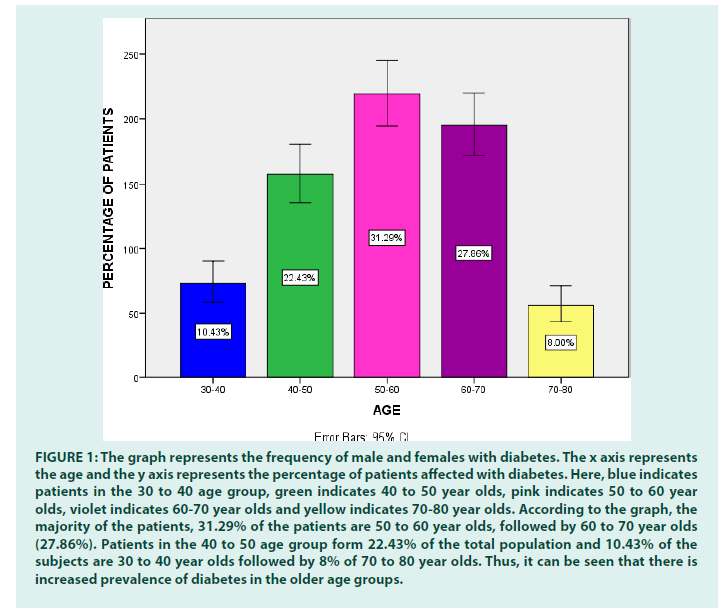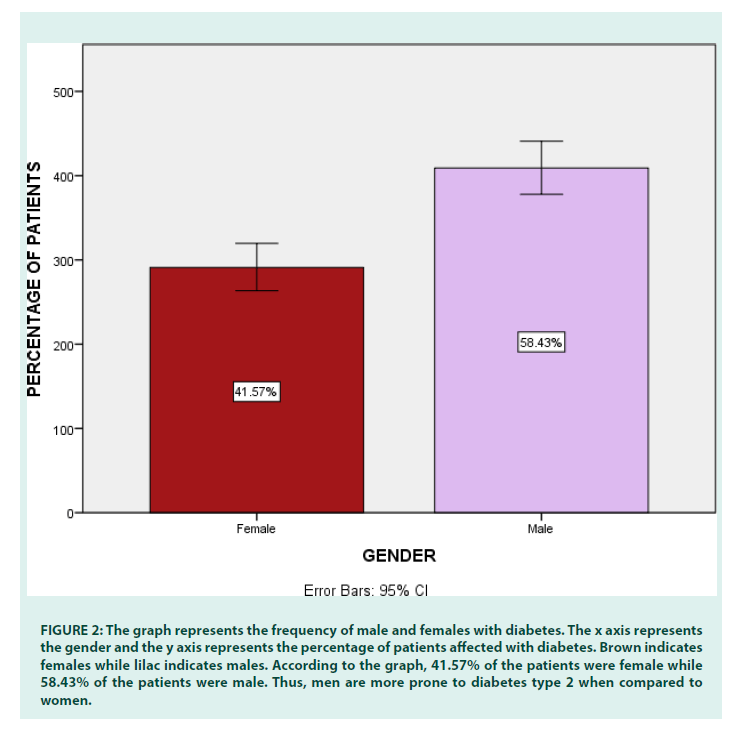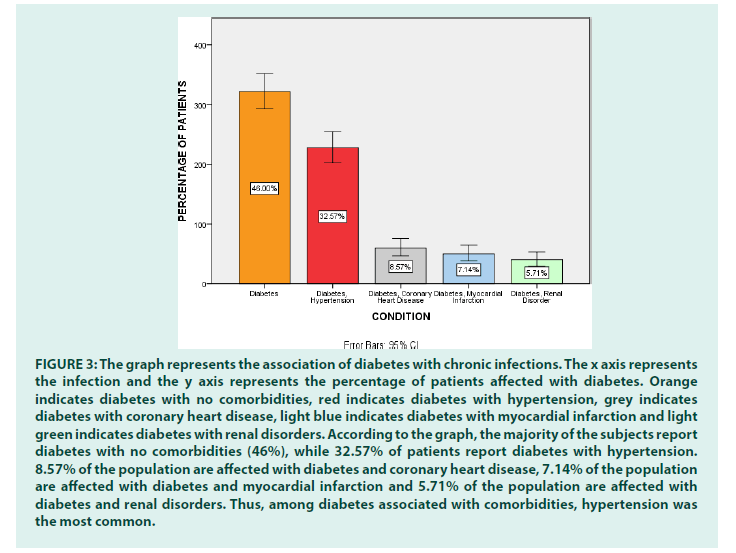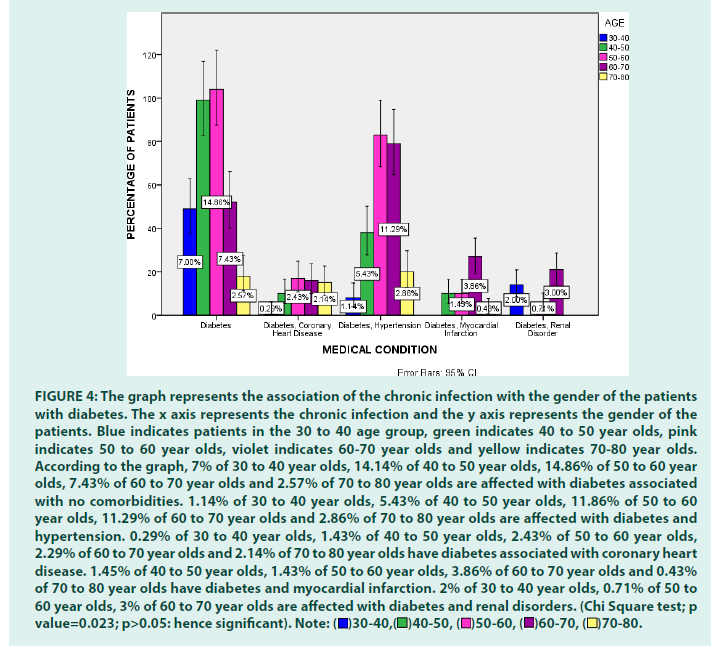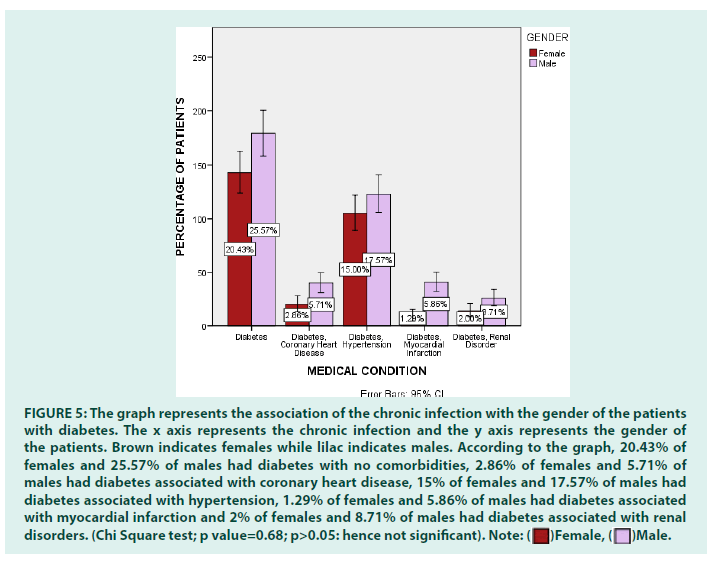Research Article - Diabetes Management (2022) Volume 12, Issue 2
Association between diabetes mellitus and chronic diseases
- Corresponding Author:
- Kathiravan Selvarasu
Department of Oral and Maxillofacial Surgery,
Saveetha University,
Chennai,
India
E-mail: kathiravan.sdc@saveetha.com
Received: 04-Feb-2022, Manuscript No. FMDM-22-47543; Editor assigned: 07-Feb-2022, PreQC No. FMDM-22-47543(PQ); Reviewed: 25-Feb-2022, QC No. FMDM-22-47543 ; Revised: 28-Feb-2022, Manuscript No. FMDM-22-47543(R); Published: 07-Mar-2022, DOI: 10.37532/1758-1907.2022.12(2).313-320
Abstract
Introduction: Diabetes mellitus is a group of chronic metabolic disorders which is characterized by impaired glucose metabolism caused by defects in the action of insulin in the human body or in the production of insulin. Diabetes has been implicated to increase the risk of hypertension, coronary heart disease, myocardial infarction and chronic renal disease. Diabetes can influence hypertension by causing sodium retention due to stimulation of the sympathetic nervous system and renin-angiotensin system. Previous researches indicate that people with diabetes are two to four times more prone to develop cardiovascular diseases leading to a higher risk of mortality. Hypothesis state that insulin resistance, excessive inflammation and visceral adiposity can be the underlying pathophysiology for thrombogenesis leading to cardiovascular diseases. Myocardial infarction is a condition that occurs when blood flow is reduced or blocked to a part of the heart leading to damage to the heart muscles. Patients with diabetes are reported to have more recurrent MI than the healthy population. This is because diabetes is associated with a state of hypercoagulability due to abnormal fibrinolytic state and function of platelets. Diabetic nephropathy is the leading cause for chronic kidney disease in diabetic patients.
Aim: In this study we assess the association of diabetes Mellitus with chronic diseases including hypertension, coronary heart disease, myocardial infarction and chronic renal disease.
Methods: From the patients visiting the private dental hospital, those diagnosed with Diabetes Mellitus were considered in the inclusion criteria. Exclusion criteria involved those with poor maintenance of records and follow-up of uncooperative patients. The final sample size was 800. The gender and age were considered and tabulated, followed by their statistical analysis using SPSS software version.
Results: In this study we observed 50 to 60 year old subjects had a higher diabetes count (31.29%) compared to other age groups. It was also seen that males (58.43%) have a greater predisposition to diabetes when compared to females (41.57%). Males can also be seen to be more susceptible to hypertension, coronary heart disease, myocardial infarction and chronic renal disease when compared to females. The most common comorbidity observed was hypertension (32.57%) with chronic renal diseases being the least common (5.71%).
Conclusion: Within the limits of this study, it can be concluded that diabetes increases the susceptibility to hypertension (32.57%), coronary heart disease (8.57%), myocardial infarction (7.14%) and chronic renal disease (5.71%). Awareness has to be spread about the diseases associated with diabetes in order for medical professionals to take precaution for the same and prevent any medical emergencies.
Keywords
diabetes; hypertension; coronary heart disease; myocardial infarction; chronic renal disease; comorbidity; novel study; innovative method
Introduction
Diabetes mellitus is a serious health concern that requires lifelong care and can lead to premature death and can produce serious complications. It is one of the most common disorders that affect the modern day population. Diabetes mellitus is a group of chronic metabolic disorders which is characterized by impaired glucose metabolism caused by defects in the action of insulin in the human body or in the production of insulin [1]. Epidemiologically, the number of diabetes cases in adults, type 1 and type 2, was estimated to be at 258 million and is expected to increase to 438 million in 2030. Countries with little or no average income are the most commonly affected [2]. The hallmark of diabetes mellitus is hyperglycemia which can lead to both acute and chronic complications which can be severe and can lead to failure of organs in the body which includes the gingival and productive tissues that support and surround the teeth [3,4]. However the link between oral diseases and diabetes mellitus has not been as widely researched as the association of diabetes and other systemic disorders [5]. Diabetic complications commonly result from disturbances in the microvascular and macro vascular structures. Systemic conditions like hypertension associated with diabetes can significantly increase the risk of vascular complications and can be a predisposing factor for cardiac and renal problems. Diabetes has also been linked to other conditions such as coronary artery disease, myocardial infarction, retinopathy, sexual dysfunction and renal disorders [6].
Hypertension in type 1 diabetes is often related with diabetic nephropathy while type 2 is more associated with obesity related symptoms over renal problems which ultimately lead to increase in blood pressure [7]. Diabetes can influence hypertension by causing sodium retention due to stimulation of the sympathetic nervous system and renin-angiotensin system. Diabetes also tends to cause increased proliferation of the vascular smooth muscle cells. This causes the impairment of the vascular endothelial cells due to elevated blood glucose levels and high blood pressure leading to increased vascular reactivity [8]. There are particular cases where the presence of hypertension with diabetes can pose a serious threat. Pre-eclamsia is more common in pregnant women with diabetes and hypertension and children with type 1 diabetes are more prone to end organ failure [9]. Undiagnosed hypertension in diabetic patients in dental settings can also likely trigger a cardiac arrest [10]. Cardiovascular diseases are currently the leading cause of death globally which accounts for about 21.9% of the total mortality rate [11,12]. Previous researches indicate that people with diabetes are two to four times more prone to develop cardiovascular diseases leading to a higher risk of mortality. This increased risk indicates the predisposition of common precursors between the two. Hypothesis state that insulin resistance, excessive inflammation and visceral adiposity can be the underlying pathophysiology for thrombogenesis. In addition, other compound mix of anatomic processes including oxidative stress, abnormal vascular reactivity, increased haemostatic activation, renal dysfunction and pronounced atherogenicity of cholesterol have been implicated as features of diabetes that can increase the risk of cardiovascular diseases.
Myocardial infarction is a condition that occurs when blood flow is reduced or blocked to a part of the heart leading to damage to the heart muscles. Patients with diabetes are reported to have more recurrent MI than the healthy population. This is because diabetes is associated with a state of hypercoagulability due to abnormal fibrinolytic state and function of platelets. These coagulability problems are generally attributed to increased aggregation of platelets and factor VII, defective fibrinolysis and increased fibrinogen levels. All these factors tend to increase the risk of recurrent MI. The contractile portion of the non-infarcted part of the heart is also affected in patients with diabetes leading to decreased compensatory function. Patients with diabetes are also at high risk for kidney disorders. Diabetes has been found to be the leading cause for kidney disease in Canada. Diabetic nephropathy is the leading cause for chronic kidney disease in diabetic patients. Other causes for CKD in diabetic patients include hypertensive nephrosclerosis and atherosclerotic changes in small or large renal arteries. On performing kidney biopsy series in type 2 diabetic patients it was observed that non-diabetic glomerular diseases including ischemic kidney disease is common among diabetic patients as compared to healthy controls. Our team has extensive knowledge and research experience that has been translated into high quality publications. Thus in this study we are assessing the interaction between Diabetes Mellitus and chronic diseases including hypertension, cardiovascular diseases, myocardial infarction and chronic kidney disease.
Methodology
This retrospective study was conducted as a university setting which includes diabetic patients of age group 30 to 80. The approval for this study was obtained from the institutional ethical committee. This study had advantages of large data availability, similar ethnicity, but it had disadvantages of smaller sample size, geographic limitation and no external validity. This was a convenience sampling conducted between June 2020 to March 2021. Data was collected from the dental records, patient management records of the Department of oral medicine. Data was collected from reviewing data of n=535951 patients. Inclusion criteria were diagnosed with diabetes. Patients without diabetes, including the incomplete and repeated data were excluded from the study. Cross verification was done using a photographic method to eliminate the errors made while recording. To eliminate bias, simple random sampling was done. Final sample size taken up for the study was 800 cases. The data obtained were tabulated in excel, imported to SPSS software by IBM, a statistical software with variables defined. The significance of this study was obtained using the statistical test, Chi- Square and the results were interpreted.
Results and Discussion
Diabetes mellitus is a group of metabolic disorders characterized by hyperglycaemia over a long period of time. It can either be due to impaired insulin production or insulin resistance. There are 2 types, type 1 is due to failure of beta cells in the pancreas that result in impaired production of insulin and type 2 is due to insulin resistance. Chronic diseases generally associated with diabetes include hypertension, coronary heart disease, myocardial infarction and renal disorders. In this study we observed that Majority of diabetic patients were 50 to 60 year olds (31.29%) and least were patients of 70 to 80 age group (8%) followed by 30 to 40 year olds (10.43%). The decreased prevalence of diabetes in 70 to 80 year old subjects may be due to decreased inflow of patients of that age. Based on the graph, it can be concluded that the susceptibility of diabetes increases with increase in age. Previous researches also recorded similar results. This is because the compound effects of increase in insulin resistance and impairment in pancreatic islet function increases with aging. Males (58.43%) have a greater predisposition to diabetes when compared to females (41.57%) (FIGURES 1 and 2).
Figure 1: The graph represents the frequency of male and females with diabetes. The x axis represents the age and the y axis represents the percentage of patients affected with diabetes. Here, blue indicates patients in the 30 to 40 age group, green indicates 40 to 50 year olds, pink indicates 50 to 60 year olds, violet indicates 60-70 year olds and yellow indicates 70-80 year olds. According to the graph, the majority of the patients, 31.29% of the patients are 50 to 60 year olds, followed by 60 to 70 year olds (27.86%). Patients in the 40 to 50 age group form 22.43% of the total population and 10.43% of the subjects are 30 to 40 year olds followed by 8% of 70 to 80 year olds. Thus, it can be seen that there is increased prevalence of diabetes in the older age groups.
Figure 2: The graph represents the frequency of male and females with diabetes. The x axis represents the gender and the y axis represents the percentage of patients affected with diabetes. Brown indicates females while lilac indicates males. According to the graph, 41.57% of the patients were female while 58.43% of the patients were male. Thus, men are more prone to diabetes type 2 when compared to
This is in concordance with previous studies which indicated that males were twice more susceptible to developing type 2 diabetes. However, females tend to have a higher mortality rate. The most common comorbidity observed in diabetes patients is hypertension (32.57%) (FIGURE 3). While diabetes can lead to hypertension, hypertension is also found to be an important risk factor for diabetes. It is followed by 8.57% of the population having diabetes with coronary heart disease, 7.14% of the population having diabetes with myocardial infarction and 5.71% of the population having diabetes with renal disorders. FIGURE 4 indicates the association between the age of the diabetic patient and chronic diseases. 50 to 60 year olds have higher prevalence of diabetes with no comorbidities (14.86%), coronary heart disease (2.43%) and hypertension (11.86%) while 60 to 70 year olds have high prevalence of diabetes with myocardial infarction (3.86%) and chronic renal disorders (3%). FIGURE 5 indicates the correlation between age and chronic diseases. Here, males can be seen to have more prevalence in all diseases when compared to females. This is in concordance with previous studies that show male gender predominance over females in hypertension, coronary heart disease, myocardial infarction and chronic renal diseases. However, this can also be due to the gender predominance in the sample population. Further studies have to be done with an equal gender ratio to find the gender predisposition.
Figure 3: The graph represents the association of diabetes with chronic infections. The x axis represents the infection and the y axis represents the percentage of patients affected with diabetes. Orange indicates diabetes with no comorbidities, red indicates diabetes with hypertension, grey indicates diabetes with coronary heart disease, light blue indicates diabetes with myocardial infarction and light green indicates diabetes with renal disorders. According to the graph, the majority of the subjects report diabetes with no comorbidities (46%), while 32.57% of patients report diabetes with hypertension. 8.57% of the population are affected with diabetes and coronary heart disease, 7.14% of the population are affected with diabetes and myocardial infarction and 5.71% of the population are affected with diabetes and renal disorders. Thus, among diabetes associated with comorbidities, hypertension was the most common.
Figure 4: The graph represents the association of the chronic infection with the gender of the patients with diabetes. The x axis represents the chronic infection and the y axis represents the gender of the patients. Blue indicates patients in the 30 to 40 age group, green indicates 40 to 50 year olds, pink indicates 50 to 60 year olds, violet indicates 60-70 year olds and yellow indicates 70-80 year olds. According to the graph, 7% of 30 to 40 year olds, 14.14% of 40 to 50 year olds, 14.86% of 50 to 60 year olds, 7.43% of 60 to 70 year olds and 2.57% of 70 to 80 year olds are affected with diabetes associated with no comorbidities. 1.14% of 30 to 40 year olds, 5.43% of 40 to 50 year olds, 11.86% of 50 to 60 year olds, 11.29% of 60 to 70 year olds and 2.86% of 70 to 80 year olds are affected with diabetes and hypertension. 0.29% of 30 to 40 year olds, 1.43% of 40 to 50 year olds, 2.43% of 50 to 60 year olds, 2.29% of 60 to 70 year olds and 2.14% of 70 to 80 year olds have diabetes associated with coronary heart disease. 1.45% of 40 to 50 year olds, 1.43% of 50 to 60 year olds, 3.86% of 60 to 70 year olds and 0.43% of 70 to 80 year olds have diabetes and myocardial infarction. 2% of 30 to 40 year olds, 0.71% of 50 to 60 year olds, 3% of 60 to 70 year olds are affected with diabetes and renal disorders. (Chi Square test; p value=0.023; p>0.05: hence significant). 
Figure 5: The graph represents the association of the chronic infection with the gender of the patients with diabetes. The x axis represents the chronic infection and the y axis represents the gender of the patients. Brown indicates females while lilac indicates males. According to the graph, 20.43% of females and 25.57% of males had diabetes with no comorbidities, 2.86% of females and 5.71% of males had diabetes associated with coronary heart disease, 15% of females and 17.57% of males had diabetes associated with hypertension, 1.29% of females and 5.86% of males had diabetes associated with myocardial infarction and 2% of females and 8.71% of males had diabetes associated with renal disorders. (Chi Square test; p value=0.68; p>0.05: hence not significant). 
Hypertension has been long observed to have a correlation with diabetes. In a study by Mitchel, it was seen that 85% of the patients diagnosed with type 2 diabetes had hypertension by the age of 50 and those diagnosed with hypertension had increased risk of impaired glucose tolerance or type 2 diabetes. The UK Prospective Diabetes Study (UKPDS), 1998, established the role of reduction of BP in order to improve the prognosis of type 2 diabetes treatment. However, recent cardiovascular outcome trials focus more on use of glucose lowering agents that decrease weight, lower blood pressure and have other beneficiary off target effects that facilitates control of cardiovascular risk and improves the cardiovascular prognosis of type 2 diabetes. In a study by Muhammad, it was found that patients with diabetes have a 2 to 4 fold higher risk of developing coronary heart disease which contributes to 65% to 70% of deaths in patients diagnosed with diabetes. Clinical trials and randomised control trials were conducted to analyse the effect of targeted, compound treatment of comorbid risk factors. Steno-II study in 2003 investigated the compressed, intensified, comprehensive control of risk factor in a randomised control trial in Danish patients with microalbuminuria. Decline in metabolic parameters were demonstrated in metabolic parameters (HbA1c values) that aid in preventing coronary heart disease (53%) for 8 years and lower fatality for cardiovascular events (59%) over a follow up of 13 years.
In a large-scale prospective cohort analysis by Alvaro, it was found that the post MI patients with dysfunction of the left ventricle had diabetes as a significant and independent indicator of cardiovascular mortality. There have been mixed results in previous researches, where some but not all studies report an increase in mortality rates for patients with diabetes followed by MI. Zuanetti and Mak observed that presence of diabetes indicated a worse prognosis in a 6 month and 1 year follow up. Community based studies such as the Corpus Christy Hear project reported that eliminating the age, sexual and racial differences, the risks of mortality was 37.4% among diabetic patients and 23.3% for patients without diabetes. However, in contrast, a study with a smaller sample size indicated that diabetes was not a single risk factor for increased death rate of MI. De Boer concluded that the key risk factors for chronic renal disease in diabetes are the duration of diabetes, non-optimal control of glycemia, blood pressure and plasma lipid. Obesity and cigarette smoking have also been implicated as risk factors for kidney diseases in diabetic patients. Advantage of this study was that it had easy access, the large availability of data and similar ethnicity. It was also used to identify the prevalence of each chronic oral lesion in diabetic patients. Limitation of this study was that it had no external validity. The sample size was small and inadequate. It was a unicentered study with a geographic limitation. The future scope was that it should be conducted as a multi centered study with extension in the geographic limitation and to create better treatment plans and prognosis for the diseases and provide awareness about the comorbid conditions associated with diabetes.
Conclusion
Within the limits of this study, it can be concluded that diabetes increases the susceptibility to chronic diseases including hypertension (32.57%), coronary heart disease (8.57%), myocardial infarction (7.14%) and chronic renal disease (5.71%). It is imperative to find the diabetes and the comorbid conditions associated with it in order to develop a better treatment plan and prognosis for the patient. Awareness has to be spread about the diseases associated with diabetes in order for medical professionals to take precaution for the same and prevent any medical emergencies. However, the study is done within the limits of the small sample size and bias of better accessibility, based on the convenience of the patients to approach the private dental hospital. Further research has to be done with a larger sample size and more diverse subjects.
Acknowledgements
The authors are thankful to the department of oral surgery, Saveetha Dental College and Hospitals, Saveetha Institute of Medical and Technical sciences and Saveetha University for providing a platform to express my knowledge.
Conflict of Interest
The authors declare no conflict of interest.
Funding
The present project is funded by:
• Saveetha Institute of Medical and Technical sciences
• Saveetha Dental College and Hospitals
• Saveetha University
• Little Holy Angels Matriculation Higher Secondary school.
References
- Dedov II. Diabetes Mellitus: Development of Technologies in Diagnostics, Treatment and Prevention. Diabetes mellitus. 13(3):6–13 (2010).
- Zhang E, Zhao Y, Hu H. Impact of Sodium Glucose Cotransporter 2 Inhibitors on Nonalcoholic Fatty Liver Disease Complicated by Diabetes Mellitus. Hepatol Commun. 5(5):736–48 (2021).
- Forgács S. Metabolic Joint Diseases and Diabetes Mellitus. Bone Joint Diabet. 11(2): 165–169 (1982).
- Bonora Enzo, Ralph A DeFronzo. Diabetes Complications, Comorbidities and Related Disorders. Springer New York (2018).
- McFarlane SI, Bakris GL. Diabetes and Hypertension: Evaluation and Management. Springer Science & Business Media, Heidelberg, Germany (2012).
- Sousa AC, Jardim TV, Costa TO, et al. Hypertensive Diabetic Patients: Incidence of Cardiovascular and Renal Outcomes in a Historical Cohort Over 11 Years. Diabetol metab syndr. 9(2):11-19 (2017).
- Aroor AR, Manrique-Acevedo C, DeMarco VG. The Role of Dipeptidylpeptidase-4 Inhibitors in Management of Cardiovascular Disease in Diabetes; Focus on Linagliptin. Cardiovasc Diabetol. 17(1):59 (2018).
- Wang R, Zhang P, Li Z, et al. The Prevalence of Pre-diabetes and Diabetes and Their Associated Factors in Northeast China: A Cross-sectional Study. Sci Rep. 9(2):22-29 2019.
- World Health Organization. World Health Statistics 2018: Monitoring Health for the SDGs, Sustainable Development Goals. World Health Organization, Geneva, Switzerland (2018).
- Fox CS. Cardiovascular Disease Risk Factors, Type 2 Diabetes Mellitus, and the Framingham Heart Study. Trends Cardiovasc Med. 20(10): 90–5 (2010).
- Diabetes and Cardiovascular Disease. The Framingham Study. Harvard University Press, Cambridge, USA (1980).
- Moss SE, Klein R, Klein BE. Cause-specific Mortality in a Population-based Study of Diabetes. Am J Public Health. 81(12): 1158–62 (1991).
